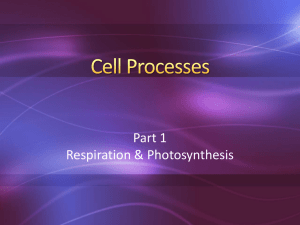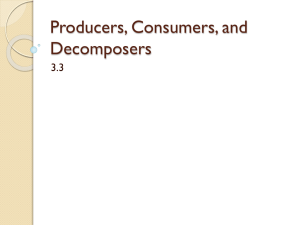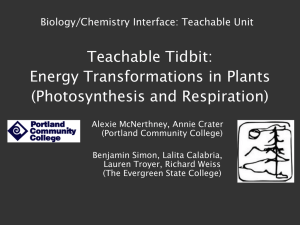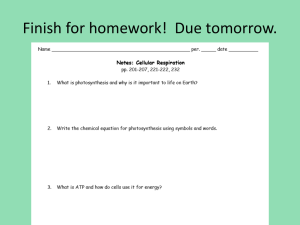2.5_Ecosystem Functions_productivity
advertisement
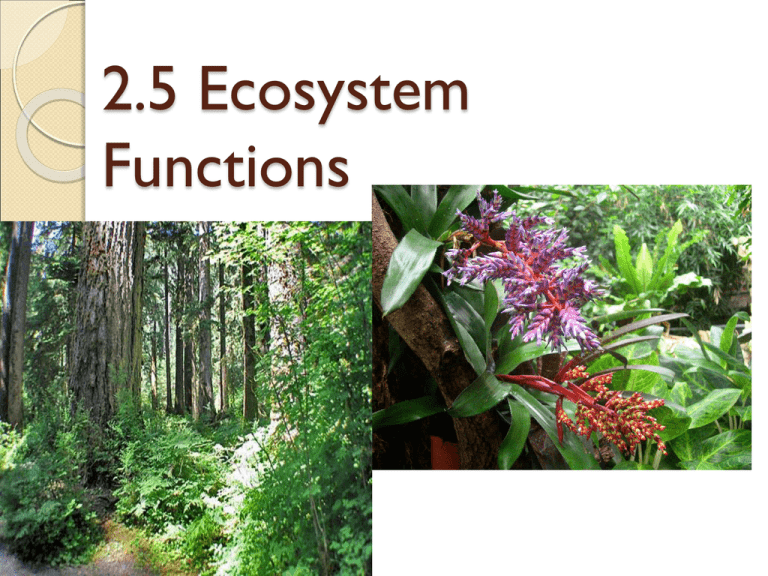
2.5 Ecosystem Functions Major Functions of An Ecosystem Producers-Convert sunlight energy into organic matter Consumers- Use living organic matter as energy to grow and develop Decomposers- Break down the dead organic matter / return nutrients to the soil ENERGY ENTERS THE ECOSYSTEM AS SUNLIGHT Only 2% of the light energy falling on plant is used to create energy The rest is reflected, or just warms up the plant as it is absorbed Photosynthesis Process where plants use sun light energy to create chemical energy Photosynthesis: equation ◦ 6CO2 + 6H2O --> C6H12O6 + 6O2 Inputs: light energy, water, carbon dioxide Outputs: oxygen gas, sugar Energy transformations: Light to Chemical respiration backwards! Respiration Process by which animals create energy through consumption of organic molecules (sugars) Respiration: ◦ C6H12O6 + 6O2 --> 6CO2 + 6H2O Inputs: oxygen gas, organic molecules (sugars) Outputs: carbon dioxide, energy in ATP, waste heat Energy transformations: chemical to heat Photosynthesis backwards! Photosynthesis and Respiration Glucose / Oxygen CO2/ Water Energy Transfers in Ecosystem Energy Flow Diagram Water Cycle Nitrogen Cycle Carbon Cycle Gross productivity Total energy captured or “assimilated” by an organism. Measured in joules (J) Plant (Gross Primary Productivity) ◦ GPP = sunlight energy used during photosynthesis Animals (Gross Secondary Productivity) ◦ GSP = food eaten - energy in faeces Energy is stored in leaf as sugars and starches, which later are used to form flowers, fruits, seeds, Net productivity The energy left over after organisms have used what they need to survive. All organisms have waste energy and respiratory loss given off as heat, metabolism (R) Plants and animals have to use some of the energy they capture to keep themselves growing: ◦ They both move water and stored chemicals around ◦ Plants make flowers, fruits, new leaves, cells and stems ◦ Animals create cells and need to move muscles. Net productivity = Gross productivity - Respiration Energy or using symbols: NP = GP - R Net Primary vs. Net Secondary Productivity (NPP) vs. (NSP) Calculate Net productivity for plants and animals NPP = GPP – R PLANTS NSP = GSP – R ANIMALS NSP GSP Productivity in Food Web In a food web diagram, you can assume that: ◦ Energy input into an organism represents the GP ◦ Energy output from that organism to the next trophic level represents the NP ◦ GP-NP = R (respiration energy ) and/or loss to decomposers ? Therefore… The least productive ecosystems are those with limited heat and light energy, limited water and limited nutrients. ◦ Example biome:_______________ The most productive ecosystems are those with high temperature, lots of water light and nutrients. ◦ Example biome:__________________ Now check you have understood! Draw a complete food web for an ecosystem of your choice, which should include: ◦ ◦ ◦ ◦ ◦ ◦ the sun and its energy named primary producers (at least 2) named primary consumers (at least 3) named secondary consumers (at least 2) named decomposers (at least 2) respiration energy loss (use red marker for this arrow) On your diagram use arrows to show direction of energy flow ◦ Complete this energy flow diagram: Label GPP, NPP and R for the primary producer Add arrows to show missing energy pathways (5 in total) Fill in the blank box to explain why some sunlight is not fixed by plant HERBIVORES PLANT SUN ……………… ……………. (~98% of energy is here) RESPIRATION DECOMPOSERS Draw your own energy flow diagram, rather like the one on the previous slide to show energy flows through the trophic levels in your food web. Include the following labels: ◦ Start with sunlight energy ◦ Include all trophic levels from your food web ◦ Include arrows showing energy moving from each trophic level to another and to decomposers ◦ Show energy lost in faeces ◦ Show Respiration loss (heat energy) USE RED MARKER! ◦ Label each individual arrow with a letter (A,B,C,D,E…) ◦ Use the lettered arrows to write an equation for GPP, NPP ◦ Write an equation for GSP, NSP for primary consumers The data in the table below relate to the transfer of energy in a small clearly defined habitat. The units in each case are in kJ m-2 yr-1 Trophic Level Gross Production Respiratory Loss Loss to decomposers Producers 60724 36120 477 1° Consumer 21762 14700 3072 2° Consumer 714 576 42 3° Consumer 7 4 1 Respiratory loss by decomposers --- 3120 --- Construct an energy flow model to represent all these data – Label each arrow with the appropriate amount from the data table above. Use boxes to represent each trophic level and arrows to show the flow of energy Calculate the Net Productivity for ◦ NPP for Producers ◦ NSP for 1°Consumers, 2°Consumers, 3°Consumers ◦ NSP for Decomposers ENERGY FLOW MODEL R=36120 60724 Producers R=576 R=14700 21762 1 Consumer 714 2 Consumer 3072 R=4 7 3 Consumer 42 477 1 Decomposers R=3120 Productivity Calculations NPP of Producers:60724 - (36120+477) NSP of 1 Consumer21762 -(14700+3072) NSP of 2 Consumer714 -(576+42) NSP of 3 Consumer7 -(4+1) NSP of Consumers: 22483 -(15280+3115) NSP of Decomposers: (477+3072+42+1) =24127 kJ.m-2.yr-1 =3990 kJ.m-2.yr-1 =96 kJ.m-2.yr-1 =2 kJ.m-2.yr-1 =4088 kJ.m-2.yr-1 -3120 =472 kJ.m-2.yr-1 How to measure primary productivity 1. 2. 3. Harvest method – measure biomass and express as biomass per unit area per unit time. CO2 assimilation- measure CO2 uptake in photosynthesis and releases by respiration 02 production-Measure O2 production and consumption Measuring productivity continued 4.Radiosotope method-use c14 tracer in photosynthesis. 5.Chlorophyl measurement- assumes a correlation between the amount of chlorophyll and rate of photosynthesis.
